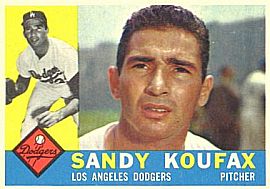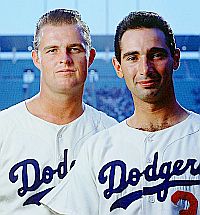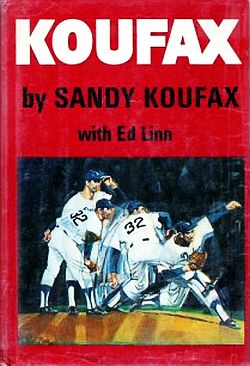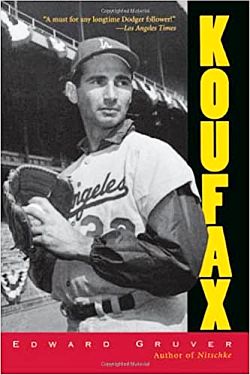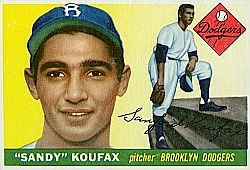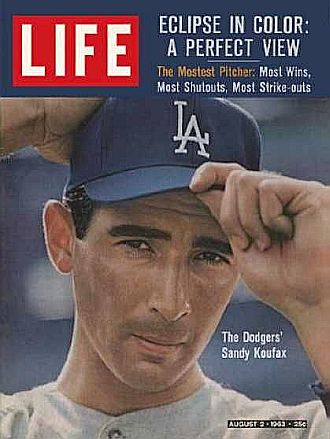
Life magazine, August 2, 1963 – “The Mostest Pitcher: Most Wins, Most Shutouts, Most Strike-outs.” Click for Amazon.
Those were the years when a number of great players roamed the fields of big league parks. Mickey Mantle was still playing then, and there were a number of other “names,” some just getting started, others in their prime — Carl Yastrzemski, Harmon Killebrew, Hank Aaron, Willie McCovey, Whitey Ford, Juan Marichal, Orlando Cepeda and others. On the Dodgers, along with Koufax, were other notables, not the least of whom was Don Drysdale, the other Dodger power pitcher from the mid-1960s.
Koufax’s career spanned a period from 1955 to 1966 — from the end of the Brooklyn Dodgers era in New York, to their early years in Los Angeles. Famous Dodgers who played in that same era included Jackie Robinson, Duke Snider, Roy Campanella, Pee Wee Reese, Jim Gilliam, Gil Hodges, Don Newcombe, Gino Cimoli, John Roseboro, among others.
But for Sandy Koufax, the mid-1960s were the awesome years. And in the post-WWII period — the more modern era of baseball — Koufax would be the only guy to win three Triple Crowns for pitching (see Triple Crown sidebar below). Yet Koufax almost missed these magical years. For there was a time in his career, at one season’s end in 1960, when he threw his glove and spikes into the trash can, believing he was through with baseball. But to his and baseball’s good fortune, he did not quit, but rather persevered, to become one of baseball’s all-time greats. Here’s a little bit of his story and his contributions to the baseball record books.
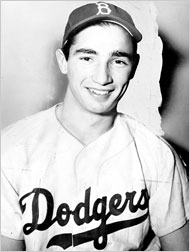
A young Sandy Koufax in his Brooklyn Dodgers uniform.
Sandy Koufax was born Sanford Braun in December 1935 in Brooklyn, New York, the child of Evelyn and Jack Braun, who divorced when Sandy was three. His mother later remarried when Sandy was nine, to Irving Koufax, who Sandy regarded as his father. Sandy attended Brooklyn’s Lafayette High School, but sports were not played there for a few years due to a teacher’s dispute. As a kid, Sandy actually played more basketball than baseball, at least at first, beginning at a local Jewish Community Center and then in his senior year for the Lafayette High School basketball team. At Lafayette High, he became team captain and ranked second in division scoring. He also played some local baseball in a youth league, and later as a 17-year old pitcher, in a Coney Island league.
At the University of Cincinnati he became a walk-on freshman basketball player. He was a good- size kid, standing at 6-foot-2 and weighing about 200-pounds. By the spring of 1954 he was also pitching for the college baseball team, and doing quite well. Koufax attracted the notice of at least one scout for the Brooklyn Dodgers. However, the scout’s glowing report on the young pitcher was reportedly lost in the Dodger front-office.
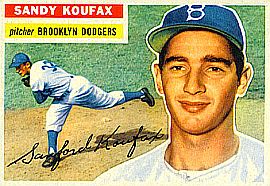
1956 Topps baseball trading card for Sandy Koufax, pitcher, Brooklyn Dodgers.
Later, another Dodger scout, Al Campanis heard about Koufax from a local sporting goods store owner, and after seeing the kid pitch locally invited him to Ebbets Field to tryout with the Dodgers. At one point in that visit, Campanis assumed the hitter’s stance in the batter’s box with Koufax on the mound. Campanis later remarked: “There are two times in my life the hair on my arms has stood up: The first time I saw the ceiling of the Sistine Chapel and the first time I saw Sandy Koufax throw a fastball.”
The Dodgers signed Koufax for a total salary and bonus package of $20,000 — or roughly $170,000 in today’s money. Thus began, in June of 1955, the professional baseball career of Sandy Koufax with the Brooklyn Dodgers.
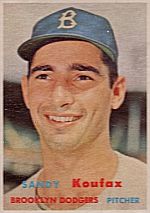
1957 Topps card, Sandy Koufax, Brooklyn Dodgers.
By 1958, meanwhile, the Dodgers’s organization left Brooklyn for the promised land of Los Angeles, breaking the hearts of millions of New Yorkers as they went.
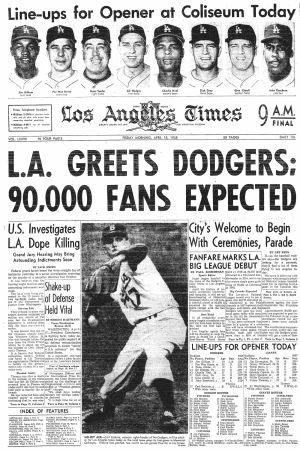
Los Angeles Times opening-day welcome to the new L.A. Dodgers, April 18, 1958. Pitcher Carl Erskine is shown in his Brooklyn uniform.
In 1959, the Dodgers won the National League pennant race and beat the Chicago White Sox in the World Series. Koufax pitched two relief innings in Game 1 of that series and started Game 5 at the Los Angeles Coliseum before more than 92,000 fans. In that game he allowed only one run in seven innings, but the Dodgers lost, 1-0.
In early 1960, Koufax asked the Dodgers to trade him because he wasn’t getting enough playing time. After going 8-13 that year, Koufax thought about quitting. He had also thought about going into the electronics business. In fact, at that season’s end he threw his glove and spikes into the trash.
In 1961, however, Koufax decided to give it one more year and see how good he could really be. He got himself into better shape, worked on his technique, and things began to break in his favor. One key change for Koufax came during spring training that year when backup catcher Norm Sherry told him ease up on his fast ball a bit, and focus more on throwing the ball over the plate. Koufax had heard that before, but now he seemed to get it, and it made him a much better pitcher. “In the past I’d go out there, and every pitch I threw, I’d try to throw harder than the last one,” Koufax would later say. “From then [1961] on I tried to throw strikes and make them hit the ball. The whole difference was control. Not just controlling the ball, but controlling myself, too.” In 1961, he compiled an 18-13 record with 269 strikeouts, breaking Christy Mathewson’s 58-year-old NL record of 267. He was also an All-Star selection that year and every year thereafter through 1966.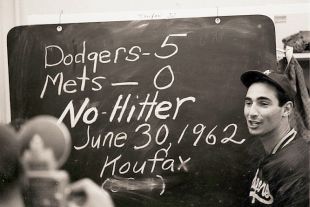
Sandy Koufax in what appears to be an impromptu locker room press conference following his no-hitter against the New York Mets of June 30, 1962.
|
“Triple Crowns” 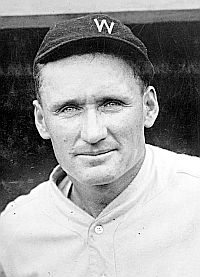 Johnson, Washington Senators, won 3 Triple Crowns: 1913, 1918 & 1924. Of the two varieties of Triple Crowns, the hitting Triple Crown is the rarer event, occurring less frequently than Triple Crowns in pitching. Still, neither is a regular occurrence, attesting to the difficulty of each. No one has won a Triple Crown in National League hitting since 1937 when Joe Medwick of the St. Louis Cardinals last did it. In the American League, Ted Williams of the Boston Red Sox won the hitting Triple Crown twice, in 1942 and 1947; Mickey Mantle of the New York Yankees did it in 1956; …To be the one best player in all three categories in a single season, whether hit- ter or pitcher, is a rare and distinctive honor, marking accomplished play.Frank Robinson of the Baltimore Orioles in 1966; and Carl Yastrzemski of the Boston Red Sox was the last hitter to do so in 1967. Triple Crowns in pitching have been reached more recently — in 2006 by Johan Santana of the Minnesota Twins in the American League, and in 2007 by Jake Peavy of the San Diego Padres of the National League. Since Koufax won his last of three Triple Crowns in 1966, there have only been four other National League pitchers who have won Triple Crowns — Steve Carlton of the Philadelphia Phillies in 1972; Dwight Gooden of the New York Mets in 1985; Randy Johnson of the Arizona Diamondbacks in 2002; and Jake Peavy in 2007. American League winners of the pitching Crown in more recent years have been Roger Clemens of the Toronto Blue Jays in 1997 and 1998, and Pedro Martinez of he Boston Red Sox in 1999. In 2011, Clayton Kershaw of the Los Angeles Dodgers, and Justin Verlander, then with the Detroit Tigers, won the National and American League Triple Crowns, respectively. It was the first time since 1924 that both leagues had pitching Triple Crown winners in the same season. In any case, to be the one best player in all three categories in a single season, whether for hitting or pitching, is a rare and distinctive honor, marking accomplished play. 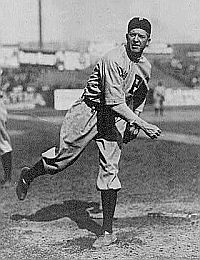 Grover Cleveland Alexander had 3 Triple Crowns, 1915, 1916 & 1920. |
Koufax in 1963
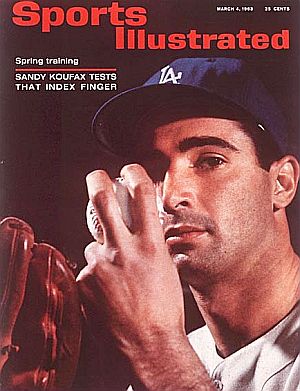
Sandy Koufax, “Sports Illustrated” cover, March 4, 1963.
By May 11th, 1963, Koufax was is very good form. On that day he carried a perfect game into the eighth inning against the San Francisco Giants, a team then powered by a bevy of capable hitters including future Hall of Famers Willie Mays, Willie McCovey, and Orlando Cepeda. Koufax only missed a perfect game that day by walking two batters: Ed Bailey in the eighth inning, and an intentional walk to Willie McCovey in the ninth. But he still no-hit the Giants, as the Dodgers won, 8-0. It was his second no-hitter.
By early August 1963, as Koufax led the majors in wins, shutouts, and strikeouts, Life magazine did a “close up” cover story on him (photo at top of article), calling him “baseball’s No. 1 hero” and its “most attractive bachelor.” In one photo he was shown in a swimming pool with a girlfriend; in another, signing autographs at a department store.

Sandy Koufax makes final pitch of ‘63 World Series. Photo, Ben Olender / L.A. Times.
He told Life reporter Tommy Thompson: “I want to enjoy all this while it lasts. The end can come any day or 10 years from now. After that, who knows? Maybe I’ll go back to where I came from and finish college.”
Koufax compiled a 25-and-5 win-loss record in 1963 as the Dodgers won the NL pennant and he became the first-ever unanimous selection for the Cy Young award for best pitcher. Koufax won the first of his three Triple Crowns that year, leading the league with 25 wins, 306 strikeouts, and a 1.88 ERA. He also threw 11 shutouts, a total that only Bob Gibson would later surpass. He was also named the National League’s Most Valuable Player.
`63 World Series
In the 1963 World Series, the Dodgers (99-63) faced the New York Yankees (104-57), with the Yankees favored to win the best-of-seven fall classic. Sandy Koufax was tapped to pitch Game 1 on October 2, 1963, as Whitey Ford, the Yankee ace, went to the mound for New York. In that game, Koufax struck out the first five Yankees he faced. Mickey Mantle, who was called out on strikes taking a Koufax curveball, walked away muttering expletives, unhappy with his Koufax experience. Mantle wasn’t alone; Koufax struck out 15 Yankees as the Dodgers won, 5-2.
Yogi Berra, the famous Yankee catcher known for his quips and his play, remarked of Koufax after watching his Game 1 performance: “I can see how he won 25 games. What I don’t understand is how he lost five.”

L.A. Dodgers’ Sandy Koufax and John Roseboro celebrate on the field in L.A. after beating the Yankees to clinch the World Series, October 6,1963.
On October 6th, 1963, in Game 4 of the World Series at Dodger Stadium, Koufax faced the Yankees a second time. In this game, Mantle would hit a homer off Koufax in the 7th inning ( Mantle’s 15th in World Series play) which tied the game temporarily at 1-1. But Koufax shut down the Yanks after that as the Dodgers won 2-1, completing a surprising four-game sweep of New York to win the Series. The Yankees batted just .171 and scored only four runs in the Series, with Koufax being a primary factor, receiving the World Series’ MVP award.
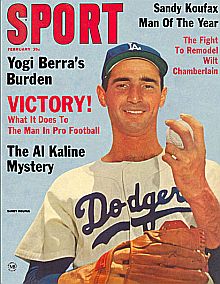
Sandy Koufax “Man of the Year” for Sport magazine, February 1964.
However, more signs of serious arm problems followed that year for Koufax, having jammed his arm in a base-running slide. In late August 1964, the morning after winning his 19th game — a shutout with 13 strikeouts — he could not straighten his arm. Dodger team physician Robert Kerlan diagnosed him with traumatic arthritis.
Koufax finished the year with a 19-5 record. The Dodgers faltered that season, going 80 and 82 for the year, finishing sixth in the ten-team National League. The St. Louis Cardinals took the pennant and beat the New York Yankees in the World Series.
Koufax in 1965
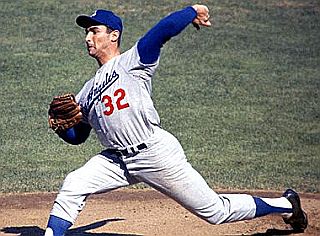
Sandy Koufax of the Dodgers making a pitch, 1960s.
In consultation with the Dodger’s team physician, Dr. Kerlan, he was told he would be lucky to pitch once a week and might eventually lose full use of his arm. Koufax sought to rest more and not throw as much between starts. He also used Empirin with codeine for pain, which he took every night and sometimes during the fifth inning to make it through a game. And he also took Butazolidin for inflammation and applied a capsaicin-based ointment to his arm known to athletes as “atomic balm” before each game.

Sandy Koufax after pitching his 4th career no-hitter, also a perfect game, Sept 9th, 1965. Click for photo plaque.
Perfect Game. The game proved to be something of a pitcher’s duel, as both Koufax and the Cubs’ pitcher, Bob Hendley, had no-hitters going until the seventh inning. Hendley finally allowed one-hit — the only hit in the game for either side. But two Dodgers managed to reach base, and one scored. The game still holds the record for fewest base runners. Koufax, meanwhile, was perfect — no runs, no hits, no walks. He retired 27 consecutive batters without allowing any to reach base. At the time Koufax was only the sixth pitcher of the modern era to throw a perfect game. He also struck out 14 batters, the most ever recorded in a perfect game.
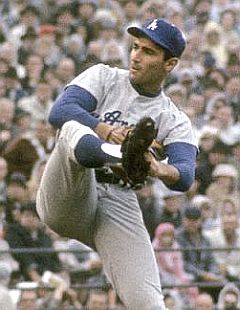
Sandy Koufax at work, Game 7, `65 World Series.
The Koufax perfect game against the Cubs was also noted for the play-by-play call by broadcaster Vin Scully, the venerable voice of the Dodgers for more than 50 years. The game is also featured in Jane Leavy’s 2002 biography of Koufax, Sandy Koufax: A Lefty’s Legacy.
Of Vin Scully’s historic broadcast of the game, one Salon.com writer, Gary Kaufman, offered this description:
“…I found …a transcript of Scully’s call of the ninth inning of Sandy Koufax’s perfect game… It read like a short story. It had tension, rising and falling drama, great turns of phrase. It was, and still is, the best piece of baseball writing I’ve ever seen. And it came off the top of his head, at a moment when, like the man whose feat he was describing, he knew he had to be at the top of his game. I’ve since heard a tape of that half inning: There’s not a single misstep. He never once fumbles for a word, makes a false start or trips over himself…”
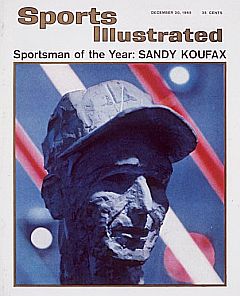
December 20, 1965 “Sports Illustrated” cover honoring Sandy Koufax.
In the 1965 World Series, the Dodgers faced the Minnesota Twins, and Koufax was the likely candidate to pitch Game 1 on October 6th, 1965. However, that day happened to be Yom Kippur, the holiest day of the year in the Jewish religion. Koufax, a Jew, refused to pitch. The incident garnered national attention as an example of conflict between social pressures and personal beliefs. Koufax, by some accounts, was neither an observant nor an involved Jew, but nonetheless, saw not playing on Yom Kippur as his responsibility. In any case, he was put under the spotlight for refusing to pitch in such a high profile game, but was regarded proudly by Jews around the world for his decision. Koufax ended up pitching two complete game shutouts in Games 5 and 7 of that World Series, with the Dodgers taking the Series, four games to three. Koufax was named “Sportsman of the Year” for 1965 by Sports Illustrated.
|
“Money Ball” In 1966, before the regular baseball season began, the Dodgers’ two key pitchers — Sandy Koufax and Don Drysdale — were each scheduled to negotiate new contracts with Dodgers’ general manager Joseph “Buzzie” Bavasi. Bavasi began by meeting separately with each man. Later, however, the two pitchers discovered that each was being used in the sessions with Bavasi against the other, saying one was asking for more than the other. With that, the two decided to negotiate their contracts as a package, demanding $1 million (about $6.7 million in current dollars) between them over three years. In negotiating with the Dodgers, Koufax and Drysdale hired an entertainment lawyer to represent them at a time when players generally did not use agents and multi-year deals were not the norm either. Willie Mays was then baseball’s highest paid player at $125,000 (about $838, 000 in current dollars). Koufax and Drysdale held out for a time and did not report to spring training in February 1966. In fact, both signed up to appear in the Hollywood movie Warning Shot, starring David Janssen — with Drysdale as a TV commentator and Koufax a detective. The Dodgers, meanwhile, played hardball with Koufax and Drysdale, mounting a public relations battle against the two. After four weeks, and some back and forth on both sides, the Dodgers made an offer both Koufax and Drysdale agreed to. Koufax ended up getting $125,000 and Drysdale $110,000 ($737,000). The front page of Los Angeles Times sports section on March 31, 1966 ran a photo of Drysdale, Bavasi and Koufax in a playful mood and all smiles as the deal was announced. “Peace at Last!,” read the headline, “K&D Return to the Fold.” Koufax and Drysdale rejoined the team in the last week of spring training. |
1966: Final Year
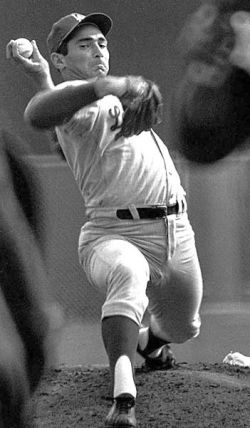
Sandy Koufax, delivering his magic from the pitching mound during the mid-1960s.
Koufax, however, kept Kerlan’s advice to himself and went out every fourth day to pitch. He ended up pitching 323 innings that year, finishing with a 27-9 record. Since then, no left-hander has had more wins in a season nor a lower ERA (Phillies pitcher Steve Carlton had 27 wins in 1972).
On September 29, 1966, near the end of the regular season, Koufax threw a four-hitter to beat the St. Louis Cardinals 2-1, achieving a third 300-strikeout season, the first major league pitcher to do so since Amos Rusie did it in 1890-92. But in the final game of the regular season, the Dodgers had to beat the Phillies to win the pennant. In the second game of a doubleheader, Koufax faced off against the Phillies’ ace, Jim Bunning in a first-ever match-up between perfect-game winners. Koufax, on two days rest, pitched a complete game, with the Dodgers winning 6-3 to clinch the NL pennant.
Koufax started 41 games that year — as he did the previous year. Only two left-handers in the ensuing years through 2000 started as many games in a season. Koufax would finish a very close second to Pittsburgh hitter, Roberto Clemente, in the National League voting that year for the regular season Most Valuable Player.
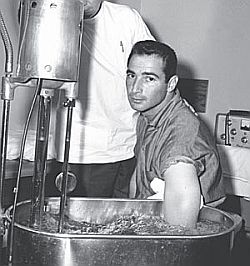
Sandy Koufax, the L.A. Dodgers’ star pitcher, soaking his arm in a whirlpool after a game in April 1964. - AP photo.
After the World Series, in November, Sandy Koufax announced his retirement from baseball due to his arthritic condition. It may have been a surprise to many fans when Koufax retired, but in 1965-1966, he was having regular and severe arm pain and had adopted various remedies to keep pitching. Here’s one account from Sports Illustrated by Tom Verducci in 1999, describing what Koufax was going through:
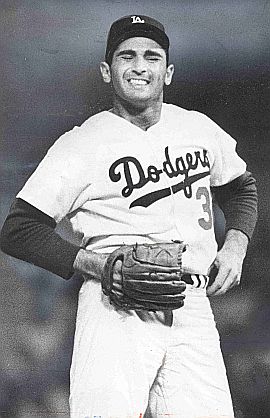
Daily Mirror/LATimes blog says this 1966 photo by Art Rodgers shows Sandy Koufax wincing in pain, but wining his 4th consecutive game, and seven for eight, May 23, 1966.
“…In the last 26 days of his career… Koufax started seven times, threw five complete-game wins and had a 1.07 ERA. He clinched the pennant for Los Angeles for the second straight year with a complete game on two days rest. Everyone knew he was pitching with traumatic arthritis in his left elbow, but how bad could it be when he pitched like that?
“It was this bad: Koufax couldn’t straighten his left arm-it was curved like a parenthesis. He had to have a tailor shorten the left sleeve on all his coats. Use of his left arm was severely limited when he wasn’t pitching. On bad days he’d have to bend his neck to get his face closer to his left hand so that he could shave. And on the worst days he had to shave with his right hand. He still held his fork in his left hand, but sometimes he had to bend closer to the plate to get the food into his mouth.
“His elbow was shot full of cortisone several times a season. His stomach was always queasy from the cocktail of anti-inflammatories he swallowed before and after games, which he once said made him ‘half-high on the mound.’ He soaked his elbow in an ice bath for 30 minutes after each game, his arm encased in an inner tube to protect against frostbite. And even then his arm would swell an inch. He couldn’t go on like this, not when his doctors could not rule out the possibility that he was risking permanent damage to his arm…”
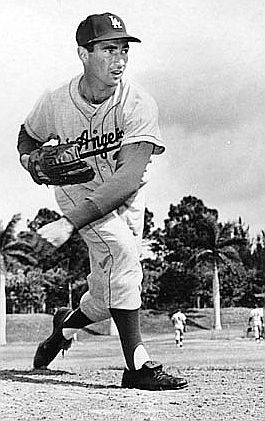
Sandy Koufax, spring training, Vero Beach, Florida, February 28, 1963.
In his major league career, Koufax set some dazzling marks. He won 25 games three times and captured five straight ERA titles from 1962 through 1966. Lefty Grove is the only other pitcher to have done the latter, in 1935-1939. Koufax also set a new standard with 382 strikeouts in 1965. His 2,396 career strikeouts at retirement in 1966 ranked 7th best all-time. Koufax also won the 1963, 1965, and 1966 Cy Young Award for best pitcher by unanimous votes — during an era when only one pitcher was chosen per season. He was the first three-time Cy Young winner in baseball. He was also the first major leaguer to pitch four no-hitters — which were also in consecutive seasons. Koufax would hold that record until 1981 when Nolan Ryan threw his fifth no-hitter. Koufax played his entire career with the Dodgers organization, from Brooklyn, New York through Los Angeles, California,1955 to1966. He was inducted into the Baseball Hall of Fame in 1972.
Koufax left baseball with the highest regard of his fellow players, as he had been a model professional, not one to seek the spotlight or boast of his abilities, and often thinking and acting on behalf of the team rather than himself. Paul Richards, who managed ball clubs in both leagues, said of Koufax, ‘This man has a sense of responsibility beyond gain and glory.” Once in 1966 when a television network offered him $25,000 to allow their cameras to follow him around, Koufax agreed to do it for $35,000, and then only if the money was divided so that every Dodger player, coach, and trainer received $1,000. Koufax also talked about his “responsibility” to pitch well enough during pennant races to help the Dodgers get into and win the World Series, thereby helping his teammates boost and even double their incomes by adding World Series’ bonus money.
After Baseball
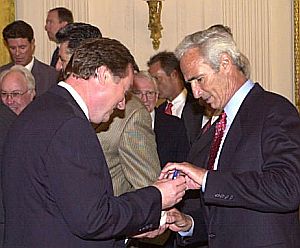
Sandy Koufax about to autograph a baseball for the late TV newsman, Tim Russert, at social gathering.
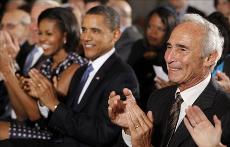
Sandy Koufax at White House reception with the President & First Lady, 2010.
As of mid-year 2010, Sandy Koufax was still active, appearing for example, at the May 27, 2010 White House reception in honor of Jewish American Heritage Month where he greeted President Obama who later joked with the audience that he and Sandy had something in common: “We are both lefties,” said the President. “He can’t pitch on Yom Kippur [and] I can’t pitch.”
Hitters’ Lament
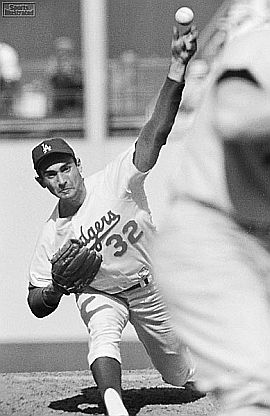
Sandy Koufax in the 1960s – no doubt, thinking about a strikeout.
“Sandy would strike me out two or three times a game,” said Willie Mays of the San Francisco Giants. “And I knew every pitch he was going to throw — fastball, breaking ball or whatever. Actually, he would let you look at it. And you still couldn’t hit it.” Pete Rose, baseball’s all-time hit leader, also had trouble hitting Koufax, batting an anemic .175 against him. Hank Aaron, it seemed, was among the few hitters that had Koufax’s number. In 114 career at-bats against him, Aaron hit .368, with an on-base percentage of .433. And Koufax admitted in one interview to having a good bit of trouble with Roberto Clemente of the Pittsburgh Pirates, especially in 1963. Others also saw a few weaknesses in Koufax. According to base-stealing threat Lou Brock of the St. Louis Cardinals, “Koufax couldn’t field bunts well or hold runners on base too well. ” Trouble was, said Brock, with Koufax on the mound, “nobody got on base too often.”
To find more sports stories at this website, please visit the “Annals of Sport” category page, or “Baseball Stories,” a topics page with thumbnail sketches and links to 14 other baseball stories. Thanks for visiting – and if you like what you find here, please make a donation to help support the research and writing at this website. Thank you. — Jack Doyle
|
Please Support Thank You |
________________________________
Date Posted: 10 July 2010
Last Update: 31 December 2020
Comments to: jackdoyle47@gmail.com
Article Citation:
Jack Doyle, “Pitcher Perfect, 1963-1966,”
PopHistoryDig.com, July 10, 2010.
___________________________________
Sources, Links & Additional Information
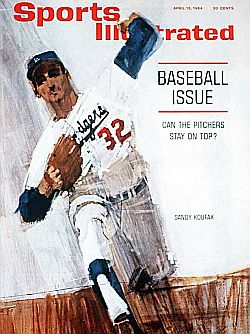 Artist's sketch of Sandy Koufax on the April 1964 cover of Sports Illustrated’s baseball issue. |
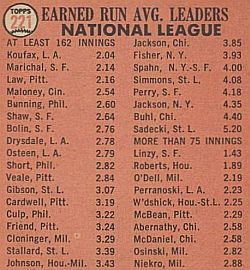 Portion of a Topps baseball card from the 1960s featuring ERA leaders of the day. |
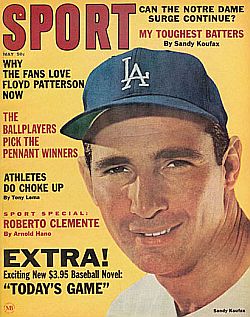 Sandy Koufax, May 1965 "Sport" magazine story about his "toughest batters.". |
Jack Olsen interview, “Koufax On Koufax,” Sports Illustrated, December 20, 1965.
Larry Schwartz, “Koufax’s Dominance Was Short But Sweet,” ESPN.com
Larry Schwartz, “Total Domination,” ESPN.com.
“Sandy Koufax,” Wikipedia.org.
Roscoe McGowen, “Dodgers Win; Koufax Is Victor Dodger Allows 2 Hits, Fans 14 in Beating Redlegs, 7 to 0,” New York Times, August 28, 1955.
Roscoe McGowen, “Brooklyn-Bred ‘Bonus Baby’ Is Coming of Age; Koufax’ 2-Hitter in 2d Start Is Sign of Maturity; Dodgers Are Getting Return on Money Paid to Hurler,” New York Times, August 29, 1955.
Roscoe McGowen, “Dodgers Top Pirates, 4-0; Koufax Blanks Pittsburgh; Brooks Need 7 for Pennant,” New York Times, September 4, 1955.
Paul Zimmerman, “Koufax Best in Baseball,” Los Angeles Times, June 27, 1962, p. B-2.
Frank Finch, “Sandy Koufax Hurls No-Hit, 5-0 Win,” Los Angeles Times, July 1, 1962, p E-1.
Frank Finch, “Koufax’s Sore Finger Cause of Concern, Says Dodgers’ Bavasi,”Los Angeles Times, July 10, 1962, p. B-1.
Frank Finch; “Koufax Wins, Shelved by Injury,”Los Angeles Times, Jul 13, 1962, p. C-1.
Dan Hafner, “Koufax Lost to Dodgers for Two Weeks,” Los Angeles Times, July 19, 1962, p. B-1.
“Sandy Koufax Out Longer Than Expected—Four to Six Weeks,” Los Angeles Times, July 20, 1962, p. B-1.
Robert Creamer, “An Urgent Matter Of One Index Finger,” Sports Illustrated, March 4, 1963.
Frank Finch, “Sandy’s Finger, Arm Ok—and How!!,”Los Angeles Times, May 12, 1963, p. I-1.
Frank Finch, “Koufax Shuts Out Milwaukee, 7-0,” Los Angeles Times, May 29, 1963, p. C-1.
Frank Finch, “Spencer’s Hit Ruins Koufax Sparkler, 1-0 ,” Los Angeles Times, June 2, 1963, p. J-1.
Frank Finch, “Koufax Blanks Giants on 4 Hits, 2-0,” Los Angeles Times, June 18, 1963, p. C-1.
Frank Finch, “Koufax Victor, Misses Shutout in Ninth,” Los Angeles Times, June 22, 1963, p. A-1.
Frank Finch, “Koufax Notches 12th Win as Dodgers Top Reds, 4-1,” Los Angeles Times, June 26, 1963, p. C-1.
Tommy Thompson, “Good Life of Baseball’s No. 1 Hero,” Life, August 2, 1963, pp. 54-56.
“Sandy Koufax, 1st Cy Young,” Detroit Free Press, October 25, 1963.
“Sandy Koufax’s Perfect Game,” Wikipedia.org.
“Los Angeles Dodgers,” Baseball Season Forecast, Sports Illustrated, April 13, 1964.
Joe Jares, “Sandy Makes A Pitch For Posterity,” Sports Illustrated, August 2, 1965.
Frank Finch, “Koufax, Drysdale Eye $1 Million Pact,” Los Angeles Times, February 23, 1966, p. B-1.
Frank Finch, “Big D, Sandy Give Bavasi News Today,” Los Angeles Times, February 24, 1966, p. B-1.
Frank Finch, “Koufax, Drysdale Spurn Record Offer by Dodgers,” Los Angeles Times, February 25, 1966, p. B-1.
“Koufax-Drysdale ‘Spokesman’ Says Next Move Up to Dodgers,” Los Angeles Times, March 3, 1966, p. B-6.
“Koufax and Drysdale Sign Pacts—as Movie Actors,” Los Angeles Times, March 18, 1966, p. B-1.
“Koufax Peddles His Biography for Tidy Advance of $110,000,” Los Angeles Times, March 19, 1966, p. A-1.
“Big D, Koufax Losing Support,” Los Angeles Times, March 22, 1966, p. B-2.
Charles Maher, Frank Finch, “Bavasi Doubts Koufax and Drysdale Will Sign,” Los Angeles Times, March 23, 1966, p. B-1.
Charles Maher, “L’Affaire Drysdale-Koufax: Villains or Heroes?,” Los Angeles Times, March 27, 1966, p. G-1.
Charles Maher, Frank Finch, “Koufax, Drysdale Reject $210,000,” Los Angeles Times, March 30, 1966, p. B-1.
“Don’t Let ‘Em Fool You; Koufax Wanted to Pitch, Los Angeles Times, March 31, 1966, p. B-1.
“Mays or Koufax?,” Los Angeles Times, April 3, 1966, p. C-3.
Frank Finch, “It’s a ‘No-Hitter’ for Sandy – And 9 Whiffs, Too!,” Los Angeles Times, April 10, 1966, p. G-1.
Associated Press, “Finally, Brilliance Succumbs to Pain,” New York Times, November 18, 1966.
Associated Press, “Koufax, Dodger Pitching Star, Retires Because of Ailing Arm; Fearing a Permanent Injury to Elbow, Hurler, 30, Stops at Peak of His Career,”New York Times, Saturday, November 19, 1966, p. 1.
Tom Verducci,”The Left Arm Of God,” Sports Illustrated, July 12, 1999.
James Lincoln Ray, “Important Facts About Sandy Koufax: Dodgers Ace May Have Been Baseball’s Best Lefthanded Pitcher,” Suite 101.com., June 12, 2008.
Gary Kaufman, “Vin Scully,” Salon.com, Tuesday, October 12, 1999.
Vin Scully, “29,000 People And A Million Butter-flies,” Vin Scully’s radio call of the ninth inning of Sandy Koufax’s 1965 perfect game, Salon.com., Tuesday, October 12, 1999.
Keith Thursby, “Sandy Koufax on Pitching and Pain, April 10, 1969,” LATimes.com, (Daily Mirror Blog), April 10, 2009.
“Koufax Cites Pressures on Pro Athletes,” Los Angeles Times, April 10, 1969, p. E-12.
“Sandy Koufax,” TheBaseballPage.com.
Sandy Koufax with Ed Linn, Sandy Koufax, New York: Viking Press, August 30, 1966, 299 pp.
Edward Gruver, Koufax, Taylor Trade Publishing, 2000.
Jane Leavy, Sandy Koufax: A Lefty’s Legacy, New York: Harper-Collins, 2002.
“Don Drysdale and Sandy Koufax” (cover story), Sporting News, July 17, 1965.
___________________________
